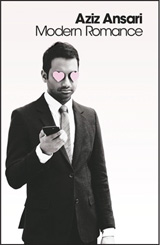
It features infinitely in most songs and poems, and has been immortalised in paintings, movies, and what have you. How then, does it fit into the regular hubbub called life?
IT SEEMS SO innocuous, that smartphone in your hand. Who would ever guess that this piece of technology has changed the way we look at love forevermore? Who knew that texting, online dating apps, and social media are not just superficially new ways to communicate, but have actually changed society and the very idea of romance?
Most of us had our suspicions, but US-based standup comedian Aziz Ansari decided to go deeper, and he got together with New York University sociologist Eric Klinenberg to research and write a book called Modern Romance: An Investigation.
What the two of them learned after conducting focus group research all over the US and in Tokyo, Paris and Buenos Aires, was not exactly startling, but is sufficiently surprising to keep you engaged with the book from beginning to end.
Essentially, Modern Romance explains that technology has changed romance in two game-changing ways. And because of these big changes, there are lots of smaller changes, too.
Ansari and Klinenberg began their research with a look at how older generations in the US came to fall in love and marry, and learned to their stupefaction that in general, people married people who lived really close to each other — in the same neighbourhood; sometimes even in the same building, showing how difficult it was for most young people of the time (1940s, 1950s) to meet new people.
Young couples of that era also tended to marry soon and early, simply because a) love had to lead to marriage and b) marriage was a must for most women because they had few other options for moving out of their parents’ homes. So in a sense the couples, already fairly familiar with each other, grew up together and developed a love that grew stronger with time — or a relationship that collapsed in a heap as soon as divorce became acceptable from the 1960s-70s onward.
Today, however, because of the explosion of online dating sites, young people can meet unlimited numbers of people for potential romance, with so many choices that commitment can safely be postponed till they are in their thirties. They can also safely spend time looking for “true love” — the kind of love in which each partner is all-in-all for the other, rather than settle for the first reasonably interesting and stable person they meet.
But the fact that each of us now has two personas -- the phone self and the real self — has made life more difficult. That’s because more and more of us chat by SMS rather than face to face, and because the people we text cannot see our faces, we tend to be more uninhibited in what we say — often in not a very good way. This means that the only way to gauge the personality of people we do not really know is by looking at their texts — and even the smallest hint of creepiness and stupidity can drive us to avoid them forever.
Because of these two tech-created issues, dating has also changed in many smaller ways, not only in the US, but all over the world. But has tech made love easier or not? The jury is still out on that one.
But ultimately, Ansari says, if you really want love, you have to meet people face to face and invest time in getting to know them, whether you meet them online or next door.
So perhaps modern romance is the same old thing after all. Or perhaps it is completely different from the romances of our grandparents’ generation. Either way, if you’re curious about winning love, Modern Romance is easy to read.
Koehler delves deep into the history of this elixir, which is as fascinating as the brew itself. Towards the end, Koehler reminds us of the current realities of the region, which are not so happy. Indian’s marquee product is fighting for its future, not just on an erratic and unpredictable monsoon, but also over unauthorised absenteeism. This particularly holds true for an industry in which artisans continue to produce teas using methods and tools that have barely changed in a century and where tens of thousands of women (and it is always women) pluck the leaves by hand every year. Another issue for Darjeeling is the separatist movement by ethnic Gorkhas, who make up three-fourths of the region’s population and essentially the entire tea industry’s workforce.
In the end, Koehler writes: “It is moving ahead, though not in step with the highest technology with which India has lately become famous, or chemical-driven concoctions, or genetically modified superstock...” But will it survive the test of the times?
